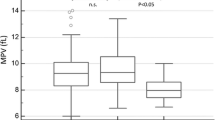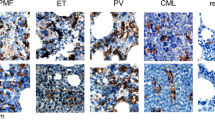Abstract
A retrospective study of 120 patients with the clinically and histologically established diagnosis of idiopathic (primary) myelofibrosis (IMF) was performed to determine prognostic factors of predictive value, including parameters characterizing the dynamics of hematopoietic cell kinetics. In contrast to previous studies, our cohort comprised the full spectrum of the disease, from initial prefibrotic to advanced osteosclerotic stages. The in situ end-labeling (ISEL) technique was used to demonstrate apoptosis, in order to determine dynamic parameters of predictive value. Cell proliferation was evaluated by employing the monoclonal antibody PC10 directed against proliferating cell nuclear antigen (PCNA). Proliferative activity (PCNA index) and frequency of apoptosis showed significant differences between early and advanced fibrosclerotic stages of disease. Decrease in proliferation indicated a significantly shorter survival, whereas a higher frequency of apoptotic cells was associated with a better prognosis. It may be speculated that a normal or enhanced proliferation rate expressed by PCNA positivity (late G1- and S-phase of the cell cycle) that is accompanied by a higher incidence of apoptosis reflects the regenerative (turnover) capacity of hematopoiesis. This may apply especially to early hypercellular stages without relevant myelofibrosis. In consideration of a recently published multivariate risk model, a simplified synthesis score for stratification of a patient's prognosis was constructed. Age, degree of anemia, leukocytes, and platelet count were regarded as the most important parameters. A substantial improvement of prognostic efficiency was further achieved by including PCNA index and frequency of apoptosis. Our results are in keeping with the assumption that generalization, indicated by myeloid metaplasia, has a prodigious impact on prognosis in IMF. Furthermore, in this context dynamic features such as proliferative activity and frequency of apoptosis exert an additional predictive value.
Similar content being viewed by others
Author information
Authors and Affiliations
Additional information
Received: July 2, 1998 / Accepted: November 19, 1998
Rights and permissions
About this article
Cite this article
Kvasnicka, H., Thiele, J., Regn, C. et al. Prognostic impact of apoptosis and proliferation in idiopathic (primary) myelofibrosis. Ann Hematol 78, 65–72 (1999). https://doi.org/10.1007/s002770050474
Issue Date:
DOI: https://doi.org/10.1007/s002770050474




